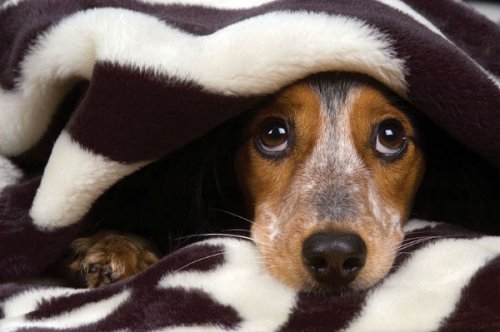Dogs and Thunderstorms
While we might welcome the rain after months of sweltering heat and humidity some of our furry companions find thunderstorms and lighting a highly traumatic event. With long periods of relative ‘calm’ weather these fears can carry over from year to year and ultimately develop into serious behavioral problems.
How can we tell ?
The first step is to recognize that your pet is developing a phobia – sometimes these signs are easy to miss!
Pets with storm phobias can exhibit a variety of behaviors, including:
- Hiding in small, enclosed spaces, under beds or furniture, in closets or bathrooms
- Intense barking, shrieking, whining or howling

- Pacing
- Drooling
- Trembling
- Destructive behavior, like chewing or scratching door frames or window sills
- Attempts to escape the house
- Aggression
What can we do ?
Fear of thunderstorms is made worse for some pets because their people mishandle the early signs of fear either by soothing the pets or punishing them.
✖ NO
“Poor baby! Don’t be afraid. Come here and get a hug!”
When puppies, young dogs and cats show concern, don’t soothe or punish them. Soothing a dog is an action that actually rewards the behavior, while punishing a pet for its reaction makes a scary event even more frightening.
✔YES
Distract them.
Give them something positive to do, such as starting a training session with lots
of treats or playing a favorite game.
In other words, ignore the storm, distract your pet and set the tone by acting unconcerned. It’s of the most importance to be gentle, calm and patient with your pet. Pets who have a negative reaction to storms or fireworks aren’t being disobedient— they are truly in a state of panic and are looking for help to deal with this traumatic event.
Keeping calm before the (next) storm
Once a pet has developed a full- blown phobia, however, fear of storms can be dangerous to all. Dogs have jumped through windows, bitten when handled or eaten through walls. If your pet is afraid of loud noises, talk to your veterinarian. He or she can make specific recommendations and help develop a treatment plan that may include counterconditioning, pheromones or products like anti-anxiety wraps and capes in an  effort to help your pet relax during storms.
effort to help your pet relax during storms.
Please do not sedate your pet – while it may seem that they are calm on the outside it often makes things much worse on the inside. If all else fails your veterinarian may discuss prescribing medication under close supervision to use just on days when there are storms.
Summary
Staying calm, not encouraging the fear and ignoring the storm will help your pet to relax and even enjoy thunderstorms when they start to associate them with ‘play time’ not ‘fear time’.
 This article has been provided by Animal Doctors International, a veterinary clinic which provides world-class veterinary care and preventative medicine in a modern environment in Vientiane, Lao PDR.
This article has been provided by Animal Doctors International, a veterinary clinic which provides world-class veterinary care and preventative medicine in a modern environment in Vientiane, Lao PDR.



